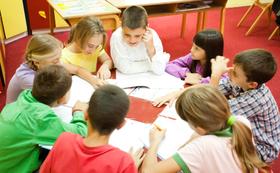Serving 753 students in grades 6-8, Rosa International Middle School ranks in the top 20% of all schools in New Jersey for overall test scores (math proficiency is top 20%, and reading proficiency is top 20%).
The percentage of students achieving proficiency in math is 68% (which is higher than the New Jersey state average of 38%). The percentage of students achieving proficiency in reading/language arts is 68% (which is higher than the New Jersey state average of 49%).
The student-teacher ratio of 13:1 is higher than the New Jersey state level of 11:1.
Minority enrollment is 48% of the student body (majority Asian), which is lower than the New Jersey state average of 62% (majority Hispanic).
Quick Facts (2025-26)
- Grades: 6-8
- Enrollment: 753 students
- Student-Teacher Ratio: 13:1
- Minority Enrollment: 48%
- Overall Testing Rank: Top 20% in NJ
- Math Proficiency: 68% (Top 20%)
- Reading Proficiency: 68% (Top 20%)
- Science Proficiency: 35% (Top 30%)
- Source: National Center for Education Statistics (NCES), NJ Dept. of Education
Top Rankings
Rosa International Middle School ranks among the top 20% of public schools in New Jersey for:
Category
Attribute
Overall Rank
Math Proficiency
Reading/Language Arts Proficiency
Diversity
School Overview
Rosa International Middle School's student population of 753 students has stayed relatively flat over five school years.
The teacher population of 60 teachers has stayed relatively flat over five school years.
Grades Offered
Grades 6-8
(No virtual instruction)
(No virtual instruction)
Total Students
753 students
Gender %
Total Classroom Teachers
60 teachers
School Calendar
School Motto
Dedicated To Excellence In Education
School Rankings
Rosa International Middle School ranks within the top 20% of all 2,184 schools in New Jersey (based off of combined math and reading proficiency testing data).
The diversity score of Rosa International Middle School is 0.65, which is less than the diversity score at state average of 0.72. The school's diversity has stayed relatively flat over five school years.
Overall Testing Rank
#333 out of 2184 schools
(Top 20%)
(Top 20%)
Math Test Scores (% Proficient)
68%
38%
Reading/Language Arts Test Scores (% Proficient)
68%
49%
Science Test Scores (% Proficient)
35%
23%
Student-Teacher Ratio
13:1
11:1
American Indian
n/a
n/a
Asian
26%
11%
Hispanic
9%
34%
Black
7%
14%
White
52%
38%
Hawaiian
n/a
n/a
Two or more races
6%
3%
All Ethnic Groups
Participates in the National School Lunch Program (NSLP)
Yes
Eligible for Free Lunch
13%
32%
Eligible for Reduced Lunch
3%
6%
School Statewide Testing
School District Name
Source: National Center for Education Statistics (NCES), NJ Dept. of Education
Profile last updated: 02/09/2025
Frequently Asked Questions
What is Rosa International Middle School's ranking?
Rosa International Middle School is ranked #333 out of 2,184 schools, which ranks it among the top 20% of public schools in New Jersey.
What schools are Rosa International Middle School often compared to?
Rosa International Middle Schoolis often viewed alongside schools like Henry C. Beck Middle School, John A. Carusi Middle School by visitors of our site.
What percent of students have achieved state testing proficiency in math and reading?
68% of students have achieved math proficiency (compared to the 38% NJ state average), while 68% of students have achieved reading proficiency (compared to the 49% NJ state average).
How many students attend Rosa International Middle School?
753 students attend Rosa International Middle School.
What is the racial composition of the student body?
52% of Rosa International Middle School students are White, 26% of students are Asian, 9% of students are Hispanic, 7% of students are Black, and 6% of students are Two or more races.
What is the student-teacher ratio of Rosa International Middle School?
Rosa International Middle School has a student ration of 13:1, which is higher than the New Jersey state average of 11:1.
What grades does Rosa International Middle School offer ?
Rosa International Middle School offers enrollment in grades 6-8 (No virtual instruction).
What school district is Rosa International Middle School part of?
Rosa International Middle School is part of Cherry Hill School District.
In what neighborhood is Rosa International Middle School located?
Rosa International Middle School is located in the Ashland neighborhood of Cherry Hill, NJ. There are 3 other public schools located in Ashland.
School Reviews
5 10/10/2025
At Rosa International Middle School...They do provide many programs such as Character Ed Programs, Student Government, and many more things. Anyways as for parent emvolvment it is very high. So many parents vollenteer for Rosa it is crazy! Acthletic program is very good as well, with so many teams to choose from: Track & Field, Basketball, Crosscountry, Baseball, Softball, Wresetling, Soccer, and many more... It is very awesome. For the teachers, not a lot, but a equal amount are raciests to people that aren't white. A small amount,but they probably do it for a cause. Rosa has gotten many trophies for basketball and ect. Music, Art, Gym, everything is here at Rosa!
Review Rosa International Middle School. Reviews should be a few sentences in length. Please include any comments on:
- Quality of academic programs, teachers, and facilities
- Availability of music, art, sports and other extracurricular activities
Recent Articles

Public School Open House & Enrollment Season Guide
A parent-focused guide to the public school open house and enrollment season, with expert questions, timelines, and decision tips.

School Supply Budget 2026: Fees, Books, Tech Costs
School Supply Budget 2026 guide for parents, covering fees, textbooks, technology, and hidden extras to plan ahead.

Education Funding in America (2025 Update)
Comprehensive 2025 update on public school funding in America, new federal and state policies, per-pupil spending, and equity challenges.





